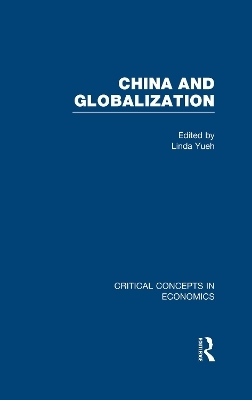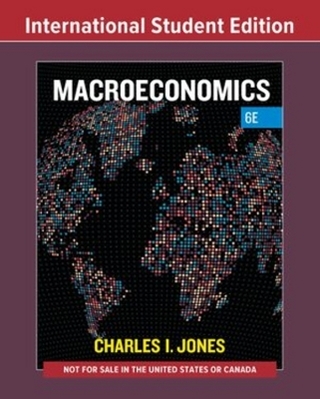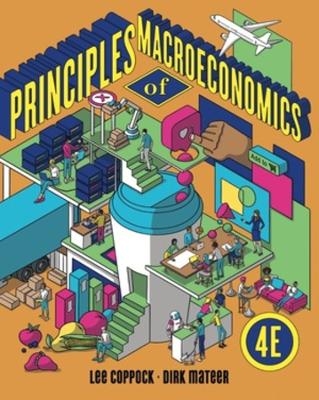
China and Globalization
Routledge
978-0-415-69786-6 (ISBN)
This subject is of growing interest because understanding the international impact of globalization on China, and the effect of China in turn on the world economy, is crucial for any analysis of the changing global system of the twenty-first century. There are already signs that the analysis of China is as important for assessing the health of the global economy, as the analysis of the United States. This timely collection examines China’s global integration, encompassing trade, investment, exchange rates, capital-account liberalization, global impact, and the linkages to growth and transition in China.
Volume I: Globalization and Chinese growth, Part 1
Gradual Liberalization and the Role of The ‘Open Door’ Policy in China’s Transition
1. L. Yueh, ‘Thirty Years of Legal and Economic Reforms in China: Growth, Institutions and Laws’, Journal of Chinese Economic and Business Studies, 2010, 8, 2, 117–32.
2. Zheng Song, Kjetil Storesletten, and Fabrizio Zilibotti, ‘Growing Like China’, American Economic Review, 2011, 101, 1, 196–233.
3. Yanqing Jiang, ‘Understanding Openness and Productivity Growth in China: An Empirical Study of Chinese Provinces’, China Economic Review, 2011, 22/3, 290–8.
4. Baizhu Chen and Yi Feng, ‘Determinants of Economic Growth in China: Private Enterprise, Education, and Openness’, China Economic Review, 2000, 11, 1, 1–15.
5. Chung Chen, Lawrence Chang, and Yimin Zhang, ‘The Role of Foreign Direct Investment in China’s Post-1978 Economic Development’, World Development, 1995, 23, 4, 691–703.
6. Kevin Honglin Zhang and Shunfeng Song, ‘Promoting Exports: The Role of Inward FDI in China’, China Economic Review, 2001, 11, 4, 385–96.
7. Y. Huang, ‘One Country, Two Systems: Foreign-Invested Enterprises and Domestic Firms in China’, China Economic Review, 2003, 14/4, 404–16.
8. J. P. H. Fan, R. Morck, L. C. Xu, and B. Yeung, ‘Institutions and Foreign Direct Investment: China Versus the Rest of the World’, World Development, 2009, 37/4, 852–65.
9. G. Wan, M. Lu, and Z. Chen, ‘Globalization and Regional Income Inequality: Empirical Evidence from Within China’, Review of Income and Wealth, 2007, 53, 35–59.
Impact of International Trade, Export-Oriented Policies, and WTO Accession
10. Barry Naughton and Nicholas R. Lardy, ‘China’s Emergence and Prospects as a Trading Nation’, Brookings Papers on Economic Activity, 1996, 2, 273–344.
11. F. C. Perkins, ‘Export Performance and Enterprise Reform in China’s Coastal Provinces’, Economic Development and Cultural Change, 1997, 45, 3, 501–39.
12. G. Yeung and V. Mok, ‘Does WTO Accession Matter for the Chinese Textile and Clothing Industry?’, Cambridge Journal of Economics, 2004, 28, 937–54.
13. Yu Zhou, ‘Synchronizing Export Orientation with Import Substitution: Creating Competitive Indigenous High-Tech Companies in China’, World Development, 2008, 36, 11, 2353–70.
14. Peter K. Schott, Clemens Fuest, and Kevin O’Rourke, ‘The Relative Sophistication of Chinese Exports’, Economic Policy, 2008, 23, 53, 5–49.
15. Dani Rodrik, ‘What’s So Special about China’s Exports?’, China & World Economy, 2006, 14, 5, 1–19.
16. Joachim Jarreau and Sandra Poncet, ‘Export Sophistication and Economic Growth: Evidence from China’, Journal of Development Economics, 2012, 97, 2, 281–92.
17. D. C. Clarke, ‘China’s Legal System and the WTO: Prospects for Compliance’, Washington University Global Studies Law Review, 2003, 2, 1, 97–118.
18. L. Yueh, ‘Global Intellectual Property Rights and Economic Growth’, Northwestern Journal of Technology and Intellectual Property, 2007, 5, 3, 436–48.
Volume II: Globalization and Chinese growth, part 2
Foreign Direct Investment and the Spillovers on Growth
19. John Whalley and Xian Xin, ‘China’s FDI and Non-FDI Economies and the Sustainability of Future High Chinese Growth’, China Economic Review, 2010, 21, 1, 123–35.
20. Jimmy Ran, Jan P. Voon, and Guangzhong Li, ‘How Does FDI Affect China? Evidence from Industries and Provinces’, Journal of Comparative Economics, 2007, 35, 4, 774–99.
21. Y. Chuang and P. Hsu, ‘FDI, Trade, and Spillover Efficiency: Evidence from China’s Manufacturing Sector’, Applied Economics, 2004, 36, 10, 1103–15.
22. Albert G. Z. Hu and Gary H. Jefferson, ‘FDI Impact and Spillover: Evidence from China’s Electronic and Textile Industries’, World Economy, 2002, 25, 8, 1063–76.
23. J. Van Reenen and L. Yueh, ‘Why Has China Grown So Fast? The Role of International Technology Transfers’ (Department of Economics, Working Paper 592, January 2012).
24. A. G. Z. Hu, G. H. Jefferson, and J. Qian, ‘R&D and Technology Transfer: Firm Level Evidence from Chinese Industry’, Review of Economics and Statistics, 2005, 87, 4, 780–6.
25. Sourafel Girma, Yundan Gong, and Holger Görg, ‘What Determines Innovation Activity in Chinese State-Owned Enterprises? The Role of Foreign Direct Investment’, World Development, 2009, 37, 4, 866–73.
26. Kui-yin Cheung and Ping Lin, ‘Spillover Effects of FDI on Innovation in China: Evidence from the Provincial Data’, China Economic Review, 2004, 15, 1, 25–44.
27. L. Yueh, ‘Patent Laws and Innovation in China’, International Review of Law and Economics, 2009, 29, 4, 304–13.
Financial Liberalization and Exchange Rate Policies to Support Development
28. Kate Phylaktis and Eric Girardin, ‘Foreign Exchange Markets in Transition Economies: China’, Journal of Development Economics, 2001, 64, 1, 215–35.
29. Haizhou Huang and Shuilin Wang, ‘Exchange Rate Regimes: China’s Experience and Choices’, China Economic Review, 2004, 15, 3, 336–42.
30. Morris Goldstein and Nicholas Lardy, ‘China’s Exchange Rate Policy Dilemma’, American Economic Review, 2006, 96, 2, 422–6.
31. Ronald McKinnon, ‘China’s Exchange Rate Trap: Japan Redux?’, American Economic Review, 2006, 96, 2, 427–31.
32. Jeffrey A. Frankel and Shang-Jin Wei, ‘Assessing China’s Exchange Rate Regime’, Economic Policy, 2007, 22, 51, 575–627.
33. K. Sato, J. Shimizu, N. Shrestha, and Z. Zhang, ‘New Estimates of the Equilibrium Exchange Rate: The Case for the Chinese Renminbi’, World Economy, 2012, 35, 419–43.
34. W. Dobson and P. R. Mason, ‘Will the Renminbi Become a World Currency?’, China Economic Review, 2009, 20, 1, 124–35.
35. Barry Eichengreen, Raul Razo-Garcia, and Giancarlo Corsetti, ‘The International Monetary System in the Last and Next 20 Years’, Economic Policy, 2006, 21, 47, 393–442.
36. William N. Goetzmann, Andrey D. Ukhov, and Ning Zhu, ‘China and the World Financial Markets 1870–1939: Modern Lessons from Historical Globalization’, The Economic History Review, 2007, 60, 2, 267–312.
37. Shahid Yusuf, ‘China’s Macroeconomic Performance and Management During Transition’, Journal of Economic Perspectives, 1994, 8, 2, 71–92.
38. M. Imam, ‘The Chinese Interbank Markets: Cornerstone of Financial Liberalization’, China & World Economy, 2004, 12, 5, 17–33.
39. Stephen L. Parente and José-Víctor Ríos-Rull, ‘The Success and Failure of Reforms in Transition Economies’, Journal of Money, Credit and Banking, 2005, 37, 1, 23–42.
40. Wendy Dobson and Anil K. Kashyap, ‘The Contradiction in China’s Gradualist Banking Reforms’, Brookings Papers on Economic Activity, 2006, 2, 103–48.
41. Xiaoming Li, ‘Reforming China’s Financial System and Monetary Policies: A Sovereign Remedy for Locally Initiated Investment Expansion?’, Journal of Development Economics, 2000, 62, 2, 423–43.
Volume III: China’s external impact and future growth in a globalized world economy
The China Effect: China’s Role in the Global Economy
42. L. Yueh, ‘The Rise of China’, Irish Studies in International Affairs, 2007, 18, 35–43.
43. Andrew F. Cooper and Thomas Fues, ‘Do the Asian Drivers Pull their Diplomatic Weight? China, India, and the United Nations’, World Development, 2008, 36, 2, 293–307.
44. Jing Gu, John Humphrey, and Dirk Messner, ‘Global Governance and Developing Countries: The Implications of the Rise of China’, World Development, 2008, 36, 2, 274–92.
45. C. Pei and L. Peng, ‘Responsibilities of China after Accession to the WTO’, China & World Economy, 2007, 15, 89–101.
46. B. Eichengreen, Y. Rhee, and H. Tong, ‘China and the Exports of Other Asian Countries’, Review of World Economics, 2007, 143, 2, 201–27.
47. Kenneth S. Rogoff, ‘Impact of Globalization on Monetary Policy’, Proceedings, Federal Reserve Bank of Kansas City, 2006, 265–305.
48. L. Yueh, ‘From the Great Moderation to the Global Financial Crisis: Emerging Markets and Reforming the International Economic System’, The Whitehead Journal of Diplomacy and International Relations, 2009, X, 2, 39–63.
49. David Victor and L. Yueh, ‘The New Energy Order: Managing Insecurities in the 21st Century’, Foreign Affairs, 2010, 89, 1, 61–73.
50. Dani Rodrik, ‘Making Room for China in the World Economy’, American Economic Review, 2010, 100, 2, 89–93.
China as Competitor and Trading Partner
51. Y. Yao, ‘China’s Integration into the World Economy: Implications for Developing Countries’, Asian Pacific Economic Literature, 2004, 1, 1, 40–57.
52. S. M. Shafaeddin, ‘Is China’s Accession to WTO Threatening Exports of Developing Countries?’, China Economic Review, 2004, 15, 2, 109–44.
53. David Greenaway, Aruneema Mahabir, and Chris Milner, ‘Has China Displaced Other Asian Countries’ Exports?’, China Economic Review, 2008, 19, 2, 152–69.
54. S. Lall, J. Weiss, and H. Oikawa, ‘China’s Competitive Threat to Latin America: An Analysis for 1990–2002’, Oxford Development Studies, 2005, 33, 163–94.
55. C. P. Bown and M. A. Crowley, ‘China’s Export Growth and the China Safeguard: Threats to the World Trading System?’, Canadian Journal of Economics, 2010, 43, 1353–88.
Volume IV: China’s external impact and future growth in a globalized world economy
Chinese Overseas Investment: Commodities to Multinational Firms
56. Frank Fuller, John Beghin, Stéphane De Cara, Jacinto Fabiosa, Cheng Fang, and Holger Matthey, ‘China’s Accession to the World Trade Organization: What is at Stake for Agricultural Markets?’, Review of Agricultural Economics, 2003, 25, 2, 399–414.
57. Raphael Kaplinsky, Anne Terheggen, and Julia Tijaja, ‘China as a Final Market: The Gabon Timber and Thai Cassava Value Chains’, World Development, 2011, 39, 7, 1177–90.
58. R. Kaplinsky, ‘Revisiting the Revisited Terms of Trade: Will China Make a Difference?’, World Development, 2006, 34, 981–95.
59. Kevin Cai, ‘Outward Foreign Direct Investment: A Novel Dimension of China’s Integration Into the Regional and Global Economy’, The China Quarterly, 1999, 160, 856–80.
60. P. Nolan and J. Zhang, ‘Globalization Challenge for Large Firms from Developing Countries: China’s Oil and Aerospace Industries’, European Management Journal, 2003, 21, 285–99.
61. P. Bellabona and F. Spigarelli, ‘Moving from Open Door to Go Global: China Goes on the World Stage’, International Journal of Chinese Culture and Management, 2007, 1, 1, 93–108.
62. E. Hong and L. Sun, ‘Dynamics of Internationalization and Outward Investment: Chinese Corporations’ Strategies’, The China Quarterly, 2006, 187, 610–34.
63. L. Sun and D. Tobin, ‘International Listing as a Means to Mobilize the Benefits of Financial Globalization: Micro-Level Evidence from China’, World Development, 2009, 37, 825–38.
Rebalancing China and its Contributions to Global Imbalances
64. Ricardo J. Caballero, Emmanuel Farhi, and Pierre-Olivier Gourinchas, ‘An Equilibrium Model of "Global Imbalances" and Low Interest Rates’, American Economic Review, 2008, 98, 1, 358–93.
65. Martin Feldstein, ‘Resolving the Global Imbalance: The Dollar and the U.S. Saving Rate’, Journal of Economic Perspectives, 2008, 22, 3, 113–25.
66. Linda Yueh, ‘The U.S., China and Global Imbalances’, China Economic Journal, 2010, 3, 1, 33–48.
67. Max Corden, ‘China’s Exchange Rate Policy, its Current Account Surplus and the Global Imbalances’, The Economic Journal, 2009, 119, 541, F430–41.
68. Alberto Bagnai, ‘The Role of China in Global External Imbalances: Some Further Evidence’, China Economic Review, 2009, 20, 3, 508–26.
69. Linda Yueh, ‘Re-balancing China: Linking Internal and External Reforms’, Asian Economic Papers, 2011, 10, 2, 85–109.
70. X. Yao and M. Zhou, ‘China’s Economic and Trade Development: Imbalance to Equilibrium’, World Economy, 2011, 34, 2081–96.
| Reihe/Serie | Critical Concepts in Economics |
|---|---|
| Verlagsort | London |
| Sprache | englisch |
| Maße | 156 x 234 mm |
| Gewicht | 3356 g |
| Themenwelt | Schulbuch / Wörterbuch ► Lexikon / Chroniken |
| Wirtschaft ► Volkswirtschaftslehre ► Makroökonomie | |
| ISBN-10 | 0-415-69786-7 / 0415697867 |
| ISBN-13 | 978-0-415-69786-6 / 9780415697866 |
| Zustand | Neuware |
| Haben Sie eine Frage zum Produkt? |
aus dem Bereich


